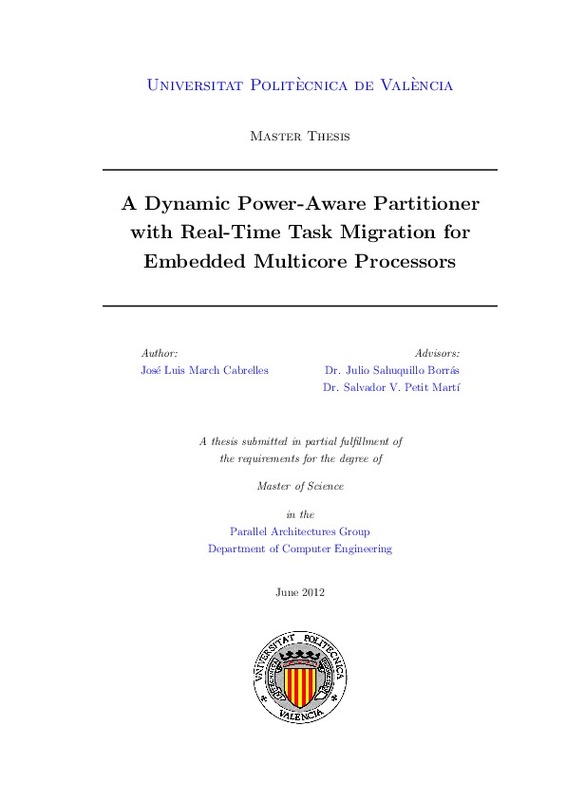JavaScript is disabled for your browser. Some features of this site may not work without it.
Buscar en RiuNet
Listar
Mi cuenta
Estadísticas
Ayuda RiuNet
Admin. UPV
A Dynamic Power-Aware Partitioner with Real-Time Task Migration for Embedded Multicore Processors
Mostrar el registro sencillo del ítem
Ficheros en el ítem
| dc.contributor.advisor | Sahuquillo Borrás, Julio
|
es_ES |
| dc.contributor.advisor | Petit Martí, Salvador Vicente
|
es_ES |
| dc.contributor.author | March Cabrelles, José Luis
|
es_ES |
| dc.date.accessioned | 2013-06-18T12:01:29Z | |
| dc.date.available | 2013-06-18T12:01:29Z | |
| dc.date.created | 2012-10-26 | |
| dc.date.issued | 2013-06-18 | |
| dc.identifier.uri | http://hdl.handle.net/10251/29847 | |
| dc.description.abstract | [ES] Analizar el impacto de permitir que las tareas de tiempo real puedan migrar su ejecución de un core a otro, sobre el consumo en sistemas empotrados multicore. | es_ES |
| dc.description.abstract | [EN] A major design issue in embedded systems is reducing the power consumption since batteries have a limited energy budget. For this purpose, several techniques such as Dynamic Voltage and Frequency Scaling (DVFS) or task migration are being used. DVFS circuitry allows reducing power by selecting the optimal voltage supply, while task migration achieves this effect by balancing the workload among cores. This work focuses on power-aware scheduling allowing task migration to reduce energy consumption in multicore embedded systems implementing DVFS capabilities. To address energy savings, the devised schedulers follow two main rules: migrations are allowed at specific points of time and only one task is allowed to migrate each time. Two algorithms have been proposed working under real-time constraints. The simpler algorithm, namely, Single Option Migration (SOM) only checks one target core before performing a migration. In contrast, the Multiple Option Migration (MOM) searches the optimal target core. In general, the MOM algorithm achieves better energy savings than the SOM algorithm, although differences are wider for a reduced number of cores and frequency/voltage levels. Moreover, the MOM algorithm reduces energy consumption as much as 40% over the typical Worst Fit (WF) strategy. | es_ES |
| dc.format.extent | 48 | es_ES |
| dc.language | Inglés | es_ES |
| dc.publisher | Universitat Politècnica de València | es_ES |
| dc.rights | Reconocimiento - No comercial - Sin obra derivada (by-nc-nd) | es_ES |
| dc.subject | Migración de Tareas de Tiempo Real | es_ES |
| dc.subject | Reducción de Consumo | es_ES |
| dc.subject | Distribución Dinámica | es_ES |
| dc.subject | Sistemas Empotrados Multinúcleo | es_ES |
| dc.subject | Real-Time Task Migration | es_ES |
| dc.subject | Power-Aware | es_ES |
| dc.subject | Dynamic Partitioning | es_ES |
| dc.subject | Multicore Embedded Systems | es_ES |
| dc.subject.classification | ARQUITECTURA Y TECNOLOGIA DE COMPUTADORES | es_ES |
| dc.subject.other | Máster Universitario en Ingeniería de Computadores-Màster Universitari en Enginyeria de Computadors | es_ES |
| dc.title | A Dynamic Power-Aware Partitioner with Real-Time Task Migration for Embedded Multicore Processors | es_ES |
| dc.type | Tesis de máster | es_ES |
| dc.rights.accessRights | Abierto | es_ES |
| dc.contributor.affiliation | Universitat Politècnica de València. Servicio de Alumnado - Servei d'Alumnat | es_ES |
| dc.description.bibliographicCitation | March Cabrelles, JL. (2012). A Dynamic Power-Aware Partitioner with Real-Time Task Migration for Embedded Multicore Processors. http://hdl.handle.net/10251/29847 | es_ES |
| dc.description.accrualMethod | Archivo delegado | es_ES |






